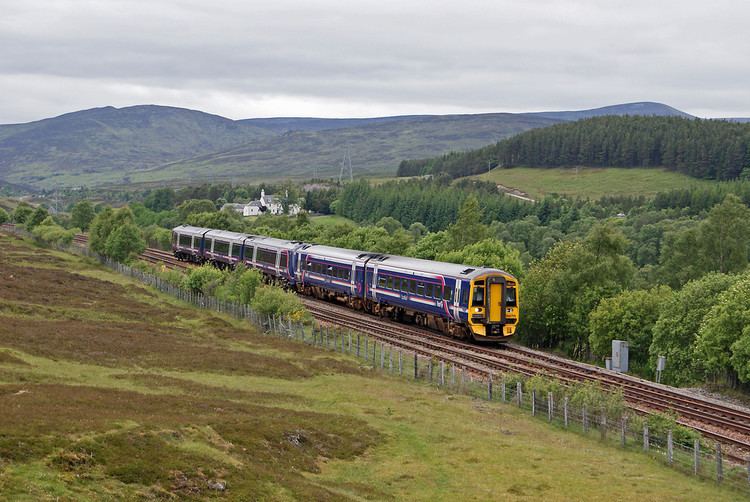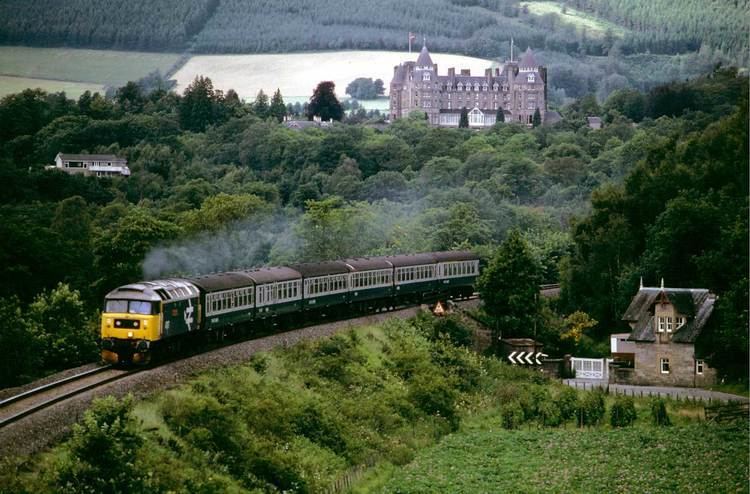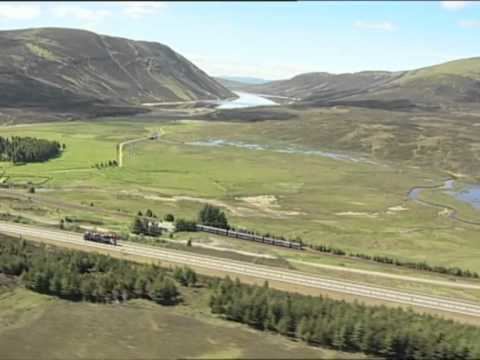Type Heavy rail Status Operational Stations 10 | ||
 | ||
Operator(s) Abellio ScotRailVirgin Trains East CoastCaledonian Sleeper Track gauge 1,435 mm (4 ft 8 ⁄2 in) Rolling stocks British Rail Class 43 (HST), British Rail Class 158, British Rail Class 170 Locale | ||
The Highland Main Line is a railway line in Scotland. It is 118 mi (190 km) long and runs through the Scottish Highlands linking a series of small towns and villages with Perth at one end and Inverness at the other. Today, services between Inverness and Edinburgh, Glasgow and London use the line. At Inverness the line connects with the Far North Line, the Aberdeen-Inverness Line and services on the Kyle of Lochalsh Line. All trains are diesel-powered, since the line is not electrified.
Contents
Much of the Highland Main Line is single track, and trains coming in opposite directions are often timed to arrive at stations at the same time, where crossing loops permit them to pass. Journey times between Inverness and Edinburgh or Glasgow are approximately three and a half hours.

Highland main line driver s eye view preview
History

The vast majority of the line was built and operated by the Highland Railway with a small section of the line between Perth and Stanley built by the Scottish Midland Junction Railway, amalgamated with the Aberdeen Railway to become the Scottish North Eastern Railway in 1856, and then absorbed by the Caledonian Railway in 1866. Originally, the line between Inverness and Perth went via Forres, but the Inverness and Aviemore Direct Railway was opened in 1898 to allow for a more direct routeing.

There are two significant summits on the line; Drumochter Summit between Blair Atholl and Dalwhinnie, and Slochd Summit between Carrbridge and Inverness. Other distinct features on the route include the viaducts at Culloden and Tomatin, the spectacular mountain pass at Drumochter and the severe gradients encountered in both directions, particularly the extended climb from Inverness to the Slochd summit which averages around 1 in 60 the whole way.
Stations and services
As of 2004, there are stations on the line as follows:

Services on the line are provided by Abellio ScotRail and Virgin Trains East Coast. A roughly two-hourly Abellio ScotRail service operates between Perth and Inverness throughout the day, with all services running from either Glasgow Queen Street (via Stirling) or Edinburgh Waverley (via Kirkcaldy). The Virgin Trains East Coast service is titled 'The Highland Chieftain'. Formed of a HST unit, it departs Inverness at around 8am and runs to London Kings Cross, via Perth, Stirling, Falkirk, Edinburgh and the East Coast Main Line, arriving in London at about 4pm. The return working leaves London at midday and reaches Inverness in the late evening.

There is also the Caledonian Sleeper operated sleeping car service that travels overnight between Inverness and London Euston via Perth, Stirling, Edinburgh Waverley and the West Coast Main Line. This joins portions from Aberdeen and Fort William at Edinburgh Waverley and south of there becomes the longest locomotive-hauled passenger train in the UK - regularly loading to 16 Mark 2/3 coaches.
All trains between Perth and Inverness call at Pitlochry, Kingussie and Aviemore. Most ScotRail services call at Dunkeld and Birnam and at Blair Atholl, with the stations at Dalwhinnie, Newtonmore and Carrbridge being served less often. On Sundays, a couple of services continue through to Elgin, calling at Nairn and Forres.
Usage
Station usage at some stations remain stable. Overall usage on the line comparing April 2003 to April 2010 has increased 154%.
